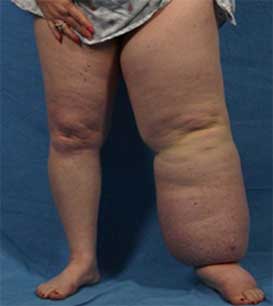Summary
Definition
History and exam
Key diagnostic factors
- history of malignancy
- history of travel to endemic filariasis area
- history of previous surgery
- history of radiotherapy
- painless unilateral swelling of extremity or genitalia
- involvement of distal extremity
- positive Stemmer's sign
Other diagnostic factors
- history of penetrating trauma to the axilla or groin
- limb heaviness and/or weakness
- non-pitting oedema
- skin changes
- family history of lymphoedema
Risk factors
- cancer treatment
- nematode infection (filariasis)
- surgery near axillary or inguinal lymph nodes
- advanced tumour, nodes, and metastasis (TNM) stage
- radiotherapy
- trauma
- curvilinear scars
- family history of lymphoedema
- genetic syndrome
- obesity
- chronic venous insufficiency
Diagnostic investigations
Investigations to consider
- MRI scan of affected extremity
- CT scan of affected extremity
- near infrared fluorescence imaging
- lymphangiography
- blood smear for filariasis
- genetic testing
Treatment algorithm
Contributors
Authors
Arin K. Greene, MD, MMSc

Department of Plastic and Oral Surgery
Boston Children's Hospital
Director Lymphedema Program
Vascular Anomalies and Pediatric Plastic Surgery Endowed Chair
Professor of Surgery
Harvard Medical School
Boston
MA
Disclosures
AKG declares that he has no competing interests. AKG is an author of a number of references cited in this topic.
Aladdin Hassanein, MD, MMSc, FACS
Associate Professor
Division of Plastic Surgery
Indiana University School of Medicine
Indianapolis
IN
Disclosures
AH declares that he has no competing interests. AH is a principal investigator in active grants on lymphoedema from the United States National Institute of Health (R21, K08), Plastic Surgery Foundation, Indiana University Health.
Acknowledgements
Dr Arin K. Greene and Dr Aladdin Hassanein would like to gratefully acknowledge Dr Reid A. Maclellan, Dr Sumner A. Slavin, and Dr Carolyn C. Schook, previous contributors to this topic.
Disclosures
RAM, SAS, and CCS are authors of a number of references cited in this topic.
Peer reviewers
Hakan Brorson, MD, PhD
Senior Consultant Plastic Surgeon
Department of Plastic and Reconstructive Surgery
Lund University
Malmoe University Hospital
Malmoe
Sweden
Disclosures
HB is an author of a number of references cited in this topic.
Neil R. Feins, MD
Professor
Harvard Medical School
Senior Surgeon
Children's Hospital Boston
Boston
MA
Disclosures
NRF declares that he has no competing interests.
Peer reviewer acknowledgements
BMJ Best Practice topics are updated on a rolling basis in line with developments in evidence and guidance. The peer reviewers listed here have reviewed the content at least once during the history of the topic.
Disclosures
Peer reviewer affiliations and disclosures pertain to the time of the review.
References
Key articles
Brix B, Sery O, Onorato A, et al. Biology of lymphedema. Biology (Basel). 2021 Mar 25;10(4):261.Full text Abstract
Manrique OJ, Bustos SS, Ciudad P, et al. Overview of lymphedema for physicians and other clinicians: a review of fundamental concepts. Mayo Clin Proc. 2020 Aug 20:S0025-6196(20)30033-1.Full text Abstract
Executive Committee of the International Society of Lymphology. The diagnosis and treatment of peripheral lymphedema: 2020 consensus document of the International Society of Lymphology. Lymphology. 2020;53(1):3-19.Full text Abstract
Reference articles
A full list of sources referenced in this topic is available here.
Use of this content is subject to our disclaimer
